Title: Alien Abduction
GistHub: https://github.com/cy1323/CelineYu/blob/master/Project%201:%20Alien%20Abduction
Project Description:
For my first project under this course, I was instructed to design a generative composition for an audiovisual sequencer. While I gathered plenty of information from both the Sound Art History course and the Early Abstract Film research, I also gathered inspiration from a course I had taken during the Summer term: Chinese Science Fiction. Within the course, I touched upon the wonders of alien narratives and extraterrestrial characteristics and cliches found throughout mainstream media as well as its history. It was also very interesting to observe the “Area 51 Raid” just last month. I wanted to reflect this curiosity of mine within this first project by modeling the visuals after an ‘alien invasion’ or ‘alien abduction’ and the melodies after what I would imagine are the sound effects that occur during such situations.
Perspective and Context:
The close-knit amalgamation of audio along with video in this project of mine indicates it as a symbiotic result of a generative audiovisual system. The array of colors used within the project are there to mirror the visuals that occur in the mind of someone who lives with the condition of synesthesia. This is how I believe my project fits into the context of synesthesia as an audiovisual system. As I’ve learned through research into synesthesia, the individual’s brain is cross-wired into a specific form that causes certain stimuli to create unique responses that are otherwise not seen in regularly functioning minds. To these synesthete individuals, the sounds they hear are translated into colors through a process commonly known as ‘color hearing’. It is through a similar process that my project incorporates the use of sound in order to instigate and create visual information. I view the project as a creation of visual music, for the system that has been created here provides the music with another means of reaching audience members. Instead of merely affecting the audience’s auditory senses, along with the vibrant colorful imagery, the listeners will for sure have their visual senses heightened as well.
I’ve taken a lot of information from the readings we’ve completed in the past few weeks into this project of mine. The most crucial piece of information I found most inspiring was from abstract film artist and pioneer visual music specialist, Oskar Fischinger. Fischinger’s work stood out to me the most with his usage of carefully selected music and minimalistic designs. His priorities and beliefs as a creator are also important to me as an artist who is still in the process of mastering the realm of visual arts alongside sound. To Fischinger, art should always be a pleasurable experience and should constantly be a place where invention and creation occurs. To follow in his footsteps, I applied his beliefs to my own work this time around.
Development and Technical Implementation:
When it came to finally creating the actual project through Max, I knew that I needed to start with a solid melodic base in order to move on to the visual portion. I thought that the best way to start off would be to apply all the information and skills I learned in class into the audio section. I started off with a drum sequencer and connected three separate Cells where I could then implement the individual audio pieces sourced from within Max itself. After tons and tons of sampling, I finally decided to go with the repercussions such as snares, bases, and cymbals to create a strong but catchy beat.
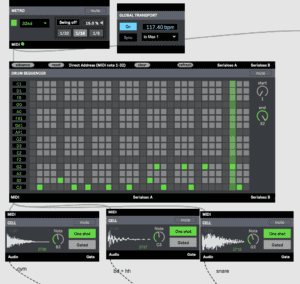
Afterward, I created a piano roll sequencer to act as the generator and base for my second synthesizer of the patch. I tried my best to stick to the format we were taught in class and followed the process of an oscillator → mixer → filter → level control and finally, an effect. This is the portion I really tried to correspond the audio into the context of an ‘alien abduction’. I edited and played around with the synthesizer until I reached a track that seemed unordinary and with a ‘warped’ feeling.
Upon completing these two audio portions, I combined them together through a Pan Mixer at the very bottom and lastly, connected them through ‘stereo’ for its output mode.
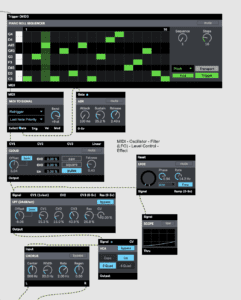
Moving on from the audio, I finally began working on the visuals. (I learned my lesson here and connected AUDIO2VIZZIE/BEAPCONVERTR between beap and vizzie modules, mentioned in Presentation) Upon converting the data values from the audio components, I connected each of them to separate SMOOTHR controller modules that would help smooth the incoming VIZZIE input data. I used these values to create the light beams with 2 1EASEMAPPRS and a LUMAKEYR module. This created the effect of lights shining down from a ‘UFO’ or ‘alien spacecraft’ as we have all seen throughout several sci-fi films. This portion was connected to the main visual module, the 3PATTERNMAPPR and put to the side.
I wanted to a few more effects and so went onto create a different path to the left. I started out with a GRANULAR beap module. (Then added in the AUDIO2VIZZIE upon reminder) I attached the data input to several vizzie generative modules such as ATTRACTR, OSCIL8R and TWIDDLR. These together would provide my visuals with a sense of movement. The effect modules of FOGGR and BRCOSR were also attached to give the visuals more depth in relation to the audio tracks above. All of these modules were then connected to randomized placements on the larger 3PATTERNMAPPR mentioned before. Afterward, I created an output device for the visuals by attaching to the bottom of the 3PATTERNMAPPR, the PROJECTR.
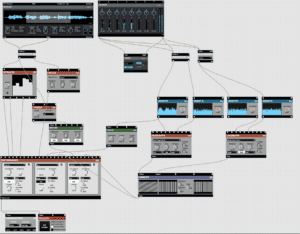
In the end, I came out with a result that I believe truly does fit within my designs of alien abduction. Its bright beams of light, as well as vibrant colors, reach an effect that resembles those found within sci-fi scenes. I am proud of the overall project.
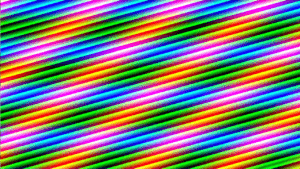 \
\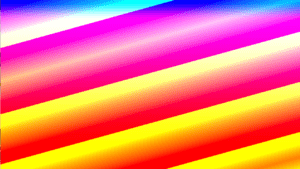
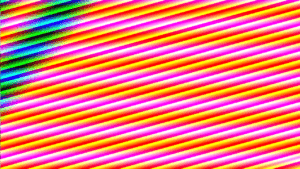
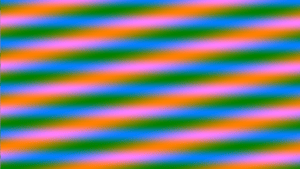
Video of Project: Screen Recording 2019-10-17 at 1.08.24 AM
Presentation:
For the presentation, I received a number of suggestions and comments upon my audiovisual creation. While others showed their admiration for the bright visuals and others for the in-depth audio, I felt that the suggestions for improvements left the greatest impression on me. There was first the suggestion provided by Professor Eric: the unspoken stigma that lingers behind using pre-recorded sounds on the Max application. He recommended that in the next project, I should strive to work myself away from such recordings in order to prevent my creations from sounding like sample products, despite my known intentions. This factor has been noted down and will be taken into consideration within the next project.
Another major suggestion I received in regards to my project concerns the relationship between audible and visual contexts. I was informed by my fellow classmates that in the next project, or if I wish to simply improve upon it, I should dive into more intricate and clear ways that can further delineate the mutually stimulating relationship that goes on between the two components. I completely agree with the comments of my peers and I know that I can achieve better results with more practice and experience with the audiovisual medium.
Lastly, I was notified during the presentation a small mistake I had made in my Max patchwork. When converting between beap and vizzie modules, I had failed to convert their data values through the usage of VIZZIECONVERTR and AUDIO2VIZZIE, damaging the project as a whole. I took this comment seriously and immediately went to change the mistake I had made following the presentation that day.
Conclusion:
This entire hands-on experience with Max has allowed me to mature a lot as an audiovisual content creator and as an artist overall. I had gone into the experiment quite overwhelmed with the amount of work I needed to have completed with an application I was still nowhere close to mastering. Luckily, I had a repertoire of readings, demos and research findings that granted me the information and inspiration needed to complete the assignment. With info on synesthesia, audiovisual systems, audio synthesizers, visual content and words of wisdom from creators such as visual art pioneer Oskar Fischinger, I created a piece that I am proud of myself for.
With the project, I learned the importance of planning ahead of time. Though I did have a general idea of the direction I wanted to head in, I was still very confused at certain points of the process and was easily frustrated when the effects I wanted to achieve were not displaying in front of me. I hope that in future projects, I can garner the courage to ask my fellow classmates and professor for assistance when I am truly confused and stuck on a problem.
This time around, I think that the factors I succeeded at most were creating an intricate and detailed audio track. I spent a lot of time working with different modules and styles until I reached a track that I was at least somewhat satisfied with. The parts I thought that needed necessary improvement was my ability to separate certain audio features to correspond with specific visual modules and pieces. I also think that it would have been beneficial for me to limit the colors involved in the visual by using another set of modules. This would have given off a more ‘green’ and ‘dark’ concept that would fit the ‘alien abduction’ theme even more. After the presentations, I was really amazed by the artworks my fellow classmates had completed and was blown away by the fluidity and cohesiveness that connected their audio and visuals together. I wish to improve upon this in the future for my next assignment.
Overall, being that this is my first real attempt at creating a cohesive audiovisual system, I am still quite satisfied with the final results. I know that there are still a lot of improvements to be made in terms of the relationships that stand between my audio and visual components, but I am confident that I will be able to create even better audiovisual systems in the future.